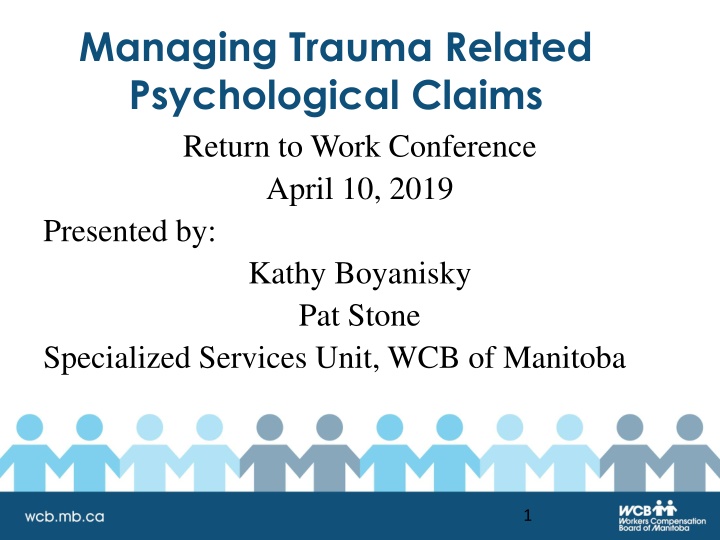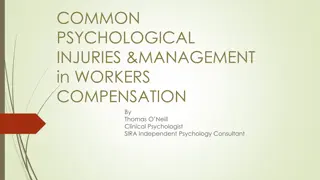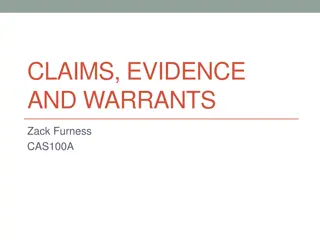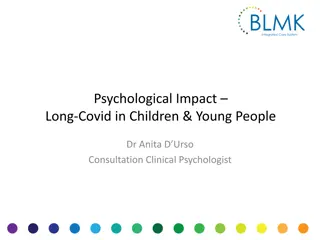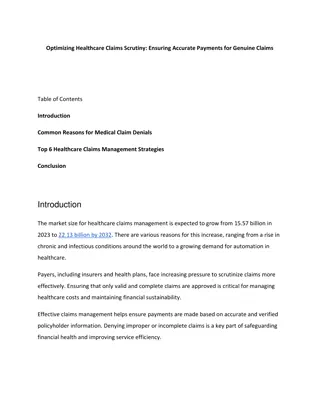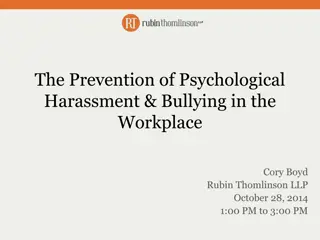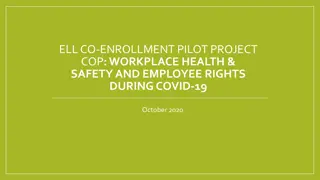Strategies for Managing Psychological Claims in the Workplace
Explore effective tools and techniques for managing trauma-related psychological claims in the workplace. Learn about common psychological diagnoses, comorbidities, and strategies for communication and intervention. Discover the importance of work-life balance and enhancing recovery outcomes for employees.
Download Presentation

Please find below an Image/Link to download the presentation.
The content on the website is provided AS IS for your information and personal use only. It may not be sold, licensed, or shared on other websites without obtaining consent from the author.If you encounter any issues during the download, it is possible that the publisher has removed the file from their server.
You are allowed to download the files provided on this website for personal or commercial use, subject to the condition that they are used lawfully. All files are the property of their respective owners.
The content on the website is provided AS IS for your information and personal use only. It may not be sold, licensed, or shared on other websites without obtaining consent from the author.
E N D
Presentation Transcript
Managing Trauma Related Psychological Claims Return to Work Conference April 10, 2019 Presented by: Kathy Boyanisky Pat Stone Specialized Services Unit, WCB of Manitoba 1
More tools Managing psychological claims is complicated. We need to better equip Case Managers with tools & resources. We need stronger controls in place accountability, monitoring, benchmarks and outcome measures. We need to create case plans that focus on treatment and work closely with community healthcare providers. 2
More tools contd We need to facilitate early and safe return to meaningful work on a timely basis that will promote better recovery outcomes and impact costs (human, family, employment, $$). Our agenda today is to respond to many of these training needs. 3
What will I learn? When you leave here you will: Have a better understanding of trauma related psychological conditions; Have different strategies on how to communicate with all stakeholders at a level that respects the health condition/claim we are dealing with; Have a better understanding of various psychological treatments and how and when to intervene as a claim owner, for better outcomes; Have more tools available to case manage challenging psychological claims. Understand the importance of work/life balance looking after you. 4
What is a psychological trauma? Trauma is caused by an overwhelmingly negative event that causes a lasting impact on the person s mental and emotional stability. Psychological trauma can leave a person struggling with upsetting emotions, memories and anxieties that are intrusive. *Psychological trauma can come from either personal experience or witnessing someone else s trauma sexual assault, threats of harm, physical assault, violent attack, a vehicle crash, attack involving a weapon, harassment and bullying, a horrific accident, a perceived or real life/death situation. 5
WCB - Most Common Psychological Diagnoses Acute reaction to a traumatic event PTSD Depression/Major Depression Anxiety Disorder 6
Comorbidity (often present in psychological claims) Depression General Anxiety Cluster B & C Personality Traits/Disorder Somatic Symptom Disorders Eating Disorders Substance Abuse Disorders Can also arise as a secondary injury requiring adjudication. 7
What can stall a Psychological recovery? Inaccurate diagnosis Other psychological issues - comorbid conditions Treatment issues not providing appropriate treatment Passive approach to recovery (lack of clear goals) No connection with a counselor or psychologist Psychologist as an advocate counterproductive No job to return to or negative work culture Ongoing symptoms create barriers to participating in therapy 8
Treatment The Three Evidence-Based Psychotherapies for PTSD. Trauma-focused psychotherapies are the most highly recommended treatment for PTSD. The three evidence-based treatments all involve some form of exposure to the memory of the traumatic event. The general time frame for these treatments are 10 to 12 weeks (with weekly treatment at first during the acute phase). 1. 2. 3. Prolonged Exposure Therapy (PET) Eye Movement Desensitization and Reprocessing (EMDR) Cognitive Processing Therapy 9
1. Prolonged Exposure therapy (PET) People with PTSD often try to avoid things that remind them of the trauma, which can help temporarily. The therapist will ask you to talk about your trauma repeatedly. This will help you get more control of your thoughts and feelings about the trauma so you don t need to be afraid of your memories. Requires increased exposure to the trigger (workplace). The exposure is also considered Desensitization . 10
2. Eye Movement Desensitization and Reprocessing (EMDR) EMDR can help someone process upsetting memories, thoughts and feelings You might focus on specific sounds or movements while you talk about the trauma. This can help you work through the traumatic memories. Over time, you can change how you react You will be asked to choose a memory from the trauma and identify negative thoughts, emotions and feelings in your body 11
3. Cognitive Processing Therapy People with PTSD often will avoid things that remind them of the trauma. This can help you feel better in the moment but not for long term and it can keep you from recovery. You need to expose yourself to the thoughts, feelings and situations that you have been avoiding. This therapy can help you identify and change your thoughts, feelings and behavious. Changing how you think about trauma can help change how you feel. 12
PTSD/Anxiety - 3 most common behaviours: > Avoidance of activities or places that trigger memories of the event. > Social isolation and withdrawal. > Lack of interest in previously enjoyable activities. 13
For the Case Manager - Start with Communication Connecting with the worker! 14
Communication Claim Owner Building a relationship with the worker Introduce yourself and explain your role (by phone). Ask permission to speak to them (phone) and confirm that this is a good time to do so. If this is the first contact, let them know that it may take 20 30 minutes so that if this is not the best time you can negotiate a better time. Make sure you set up a time to meet in person (let them know that it will take at least 1 hour). Let them know what your expectations are for ongoing contact. Advise them of our practice of not paying for missed counselling appointments (in the introductory letter). The first contact may not be the time to ask them to re-tell the story of their injury ask them how they feel talking about the incident. 15
Communicationcontd.. Actively listen. Use open ended questions to open up the discussion. Be empathetic acknowledge their feelings. Ask them how they are show concern for their well-being. Apologize for the fact that they are dealing with a sensitive and difficult situation. I am sorry this happened to you . Paraphrase back to them what you heard so that they feel validated and understood. Encourage; help set future focused goals. 16
Communicationcontd.. When you are meeting in person, make sure you are in a comfortable setting, facing each-other in an informal manner. Lean in and make eye contact so that you can both be invested in the conversation. Learn to read body language and conduct yourself accordingly. Always summarize the meeting at the end. Provide a letter to the worker to send an introduction to the process which outlines mutual expectations. Let the worker know you need an update from them every 4 6 weeks. The clearer you are up front the better the worker understands what to expect. 17
Communicationcontd.. If needed, you can ask a worker to recount the details of their incident in a sensitive and caring manner. How to ask about the incident? This should be done after you have met with them before so that you have the base of a relationship started. Ask permission. Let them know you understand this is difficult. Invite them to stop if they need to and to take their time. Tell them it is ok to defer the story to another meeting if needed. Can I clarify some of the details of the story? There may be no need to have the client retell their story in full. If they are unable to talk about it, then postpone the discussion to a later date. Ensure the worker knows who to call (resources) in a crisis. (family, doctor, Klinic, Hospital). 18
Recovery Norms: Research on PTSD shows that a substantial number remit within 6 months, a majority within 2 years, and a minority persist for many years. Remember that having ongoing symptoms and not being 100% recovered does not mean the worker is totally disabled and cannot work or actively participate. The purpose of therapy is to provide coping strategies and tools to help the worker function independently in every day life and work. 19
The Doctor is in charge **The worker s medical care remains under the direct control of the family physician who needs to be included in any referrals made to other Health Care providers and copied on all related communication. 20
Financial Stewardship in authorizing Psychological treatment. There is no formal contract between the WCB and Psychologists. The currently accepted recommended rate is $180.00 per session (1 hour). as directed by the Manitoba Psychological Society Make sure you and the treatment provider are clear on what is expected in terms of sessions (how long, how often), costs and reports. Ask and set the expectation at the outset with a letter: For example, I would like a narrative of the psychological history of the worker during the assessment phase, but do NOT require this to be repeated in each report with a $ fee. 21
What to look for in a Psychological report in terms of progress: Objective improvement observed improvement in mood, cognitive functioning, lowered trauma response on exposure, increased functioning (in all realms), decreased avoidance. Subjective improvement report of decrease in symptoms (mood & trauma), improved sleep, increased functioning. Good engagement in treatment both in the office and with homework (particularly exposure). Attendance at appointments. 22
What to ask the treating Psychologist: Provide one of the evidence-based treatments for PTSD: EDMR, Prolonged Exposure or Cognitive Processing Therapy. For information about the worker s objective, subjective status and their engagement with treatment. The treatment plan and readiness to return to work. Outcome measures to help monitor recovery, if that is part of the psychologist s protocol (eg GAF, BDI, CAPS). NOTE: these measures may be of limited use in an insurance population. 23
Ask the Psychologist for restrictions Psychologists can be asked for opinions about general restrictions but should know that they don t dictate decisions about the restrictions (claim owners do). A rationale for recommended restrictions should be provided. Restrictions should be outlined in functional terms (activity limitations vs situational) It is important to inform the Psychologist if the employer can accommodate, so that other opportunities for increased structure in the workers lives and exposure to the feared workplace situations can be incorporated into the treatment. Can the worker visit the workplace? Meet with co-workers? Watch videos of workplace situations? If the employer can accommodate, ask the Psychologist to address work readiness and counsel the worker around promoting RTW. 24
Flags There are many red flags that are often associated with poor prognosis, poor engagement in treatment and RTW, including: Unhelpful beliefs about PTSD and about disability. History of poor resilience/coping with psychosocial stressors. No progress in decreasing avoidance of activities, social support networks, workplace. Concurrent mood disorder and/or past history of mood disorder. History of trauma. Negative beliefs and feelings about the workplace and about support by coworkers and supervisors. Catastrophizing. Being pre-occupied with symptoms and disability, rather than on abilities. 25
Flagscontd.. Personality disorders. Poor job satisfaction. Concurrent major life stressors unrelated to the workplace injury. Financial issues and unhappiness with claims process. Family, friends, coworkers with unhelpful beliefs, influencing the worker. Psychological provider with unhelpful beliefs about the insurer and/or not providing appropriate treatment. Focus on the media and/or workplace on PTSD, without adequate information being provided. Co-morbid conditions; secondary injuries. 26
Frequency and content of reports This may vary, depending on treatment being used and the status of the worker. In general, treatment should be approved in blocks of 5 sessions, with a report following. Reports should include information about the diagnosis, type of treatment being used, frequency of sessions, workers degree of engagement, treatment plan and opinion about readiness to begin RTW. Should also include a psychosocial history, history of other stressors, past psychological history in the initial report. In progress reports, there also should be information about worker engagement, and specific objective and subjective improvements. What activities and/or homework is the worker engaged in? 27
Meeting with the Psychologist & Worker Meetings are optional but are very helpful for all parties; for the claim owner to meet with the psychologist and the worker, when complex issues arise. For complex PTSD claims the claim owner may wish to meet with the psychologist after around 8 sessions. This can be tied to a number if issues: lack of progress, RTW, question on diagnosis or treatment or to address a red flag. What do I say? Have a prepared agenda; share this ahead of time with the Psychologist; start with asking how treatment and recovery are progressing . The more specific the meeting agenda (RTW, red flags, etc) the better the meeting content will have on an overall goal with discussion points. 28
Checklist Ask permission of the worker to attend a meeting with the psychological and the worker. (*you would not attend a therapy session) What is your reason? Contact psychologist to arrange to attend a meeting explain the purpose. At the meeting with the psychologist and worker, review the purpose and goals. Guide the parties through that discussion and listen. Interject and participate when necessary provide information and ideas of what the plan might look like. Summarize and get feedback/buy-in. 29
Case Conference Why? A case conference can be for many reasons what is the plan for moving forward? A request can also come from the treating providers. Most often will be when the claims issues are complex, recovery stalled, lack of progress, co-morbid issues or multi-level barriers. Conference often includes treating Psychologist, Psychiatrist, GP, Claim Owner. Generally does not include the worker. Goal is to work as a team to come up with a short and long term plan to move claim forward that includes what each stakeholder is responsible for. 30
When would we consider changing the treatment provider? If the treatment is not appropriate for the compensable condition and/or if progress is stalled, we should consider no longer funding the treating psychologist; treatment should be funded if it is likely to result in a sustained benefit. Always good strategy to share your concerns with the treating psychologist and partner with them to change or alter treatment if no change is occurring, then moving to another treatment provider is considered. It is the goal of all case management to ensure that appropriate treatment is provided. 31
Working with the treating Psychologist Just like any claim, WCB does not treat the worker we monitor and track external treatment and often when it stalls or is not working, we explore alternatives with the treatment provider and the worker. In psychological claims, it is critical to review closely, and may include meeting with the psychologist and client when complex issues arise. This demonstrates your investment in the recovery process and partners you with the psychologist and worker through the recovery and return to work. We also acknowledge how critical it is for the worker to maintain activity, health and engagement in life between psych appointments which is challenging in most psych claims as the symptoms often isolate the worker and impact all areas of their life. 32
Working with the Psychologist cont d There are many creative ways to help recommend, support and enhance overall well-being and treatment progress by working with the team (doctor, psychologist and worker). Options to consider use Support Worker to help them through desensitization tasks (under the direction of the psychologist); fitness programs; community activity. 33
Other supports: Rehabilitation Support Workers (RSW) *When the psychologist includes desensitization or activity in the community as part of the treatment but does not have a proctor or support worker to supervise, WCB may consider authorizing an external provider to work closely with the psychologist, worker and claim owner. *A RSW can provide supervision, follow OT, PT, SLP and Psychologist programming and assist clients in the community. An RSW enables a client to develop, maintain or restore physical, social and cognitive skills according to the treatment plan. *For example, a RSW can assist psychologist s treatment plan for desensitization supervising the worker to expose themselves closer and closer to the trigger (workplace) so that eventually the impact of the trigger decreases or is neutralized. 34
Other Supports contd We know that keeping active and engaged is a large part of psychological recovery, particularly when the symptoms often result in isolation and loss of enjoyment of life. Options to support activity include: the authorization of a gym pass (needs to be provided on a time limited basis with checks and balances in place like attendance confirmation). Encouraging community outings and activity even better if this connects the worker with co-workers and colleagues (WCB does not cover costs of activities) Engage with the worker and psychologist to explore all the options. 35
Symptoms of PTSD most common Reliving the event. Avoiding things that remind you of the event. Having more negative thoughts and feelings than before. Feeling on edge Withdrawal from others disconnected Isolation Lack of interest in previously enjoyable activities. 36
Psychological Homework Exposure therapy is a good tool as part of therapy, to deal with the symptoms & behaviours. Workers left to do their own exposure therapy are often isolated, and avoid activities that raise the level of anxiety. The treatment provider can assist by using a support worker to oversee and monitor. As this is part of therapy, this needs to be done in conjunction with the psychologist. 37
Communication by letter setting the tone and expectations for the relationship All letters should include: What is it you are requesting or communicating at the outset the purpose of this letter is to . Provide a brief summary (being respectful of FIPPA and PHIPA) A clear outline of what you expect provide me with a report to include the following or to clarify our mutual responsibilities with the following recommendations Time frames or # of treatment sessions approved (how long is each session). Always include the family physician (who manages the worker s overall healthcare) in all correspondence. Include the job description or available job duties to the treatment providers. 38
Confirming diagnosis of psychological conditions (PTSD) Psychologist or Psychiatrist should be making the diagnosis related to PTSD. To be based on DSM-5 criteria. To be referenced in a report explaining how the diagnosis meets the DSM-5. There is a risk that the family physician is using the label of PTSD, without the rationale of how it fits the DSM-5. The question is please provide me with your mental health diagnosis, and include how this condition meets the DSM-5 criteria. 39
Plan off track? Not moving forward? What now? Identify what is off track and why. Review your case plan. Consult with your colleagues. Discuss/meet with treating Psychologist (ensure communication also continues with the treating practitioner) Share your concerns with the worker ask for their input (be curious). Arrange a case conference include key stakeholders and brainstorm options. 40
Mitigation tips for managing non-participation We need to respond when the worker is not participating, however, the language we use to deliver the information needs to be clear and concise; we need to get our point across using plain language, but we are going to do it in such a way it does not sound processed/systematic/beaurocratic. *some examples include: worker not attending for psych treatment/missing appointments/not following through. continued issues are related to pre-existing or other mental health/lifestyle or personal conditions. 41
Mitigation example Fred has not been attending his Psychologist appointments. *Delivering the mitigation information in a caring way being cognizant that Fred is experiencing stress symptoms related to his mental health condition. *Ask why? Brainstorm solutions. Address barriers...then Fred, going to your psychological appts is necessary for you to get the help you need. I know it can be hard to make yourself go when you don t feel like it, or when you are anxious, but you must go. In order for me to continue to work with you, you must attend your appts/treatment. How can I help you with a plan to get to your appts? You can use an analogy if you had a broken leg you would need to attend physio or treatment required to get better; this is the same. 42
Claim Owners, Compassion Fatigue & Self Care Compassion fatigue is the stress associated with the caring and compassion that occurs in the social service field. Compassion fatigue is different than burnout. There can be emotional residue in working with others who are suffering. Professionals who listen to stories of fear, pain and suffering may feel similar fear, pain and suffering because they care. It s alright to have some emotions. Be upset, disappointed, or frustrated. 43
Self CareContd.. Take care of yourself as it is important to prevent your own compassion fatigue. Follow these tips to help avoid fatigue: Self regulate Meditate Know your limits Take breaks Keep a sense of humor/have fun Share thought and feelings Debrief Support each other Exercise/healthy lifestyle 44
Questions? 45
